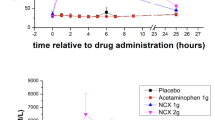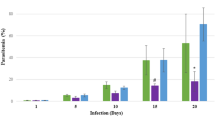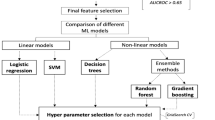Abstract
Although major depression (MD) and cardiovascular disease (CVD) have been conclusively linked in the literature, the mechanism associating MD and CVD is yet undetermined. The purpose of this paper is to further investigate a potential mechanism involving nitric oxide (NO) and to examine the effect of the selective serotonin reuptake inhibitor paroxetine on NO production by both platelets and the endothelium. In total, 17 subjects with MD and 12 healthy controls (HCs) with no known history of cardiovascular illness completed the study. Paroxetine was administered to both the MD patients and HCs over an 8-week period, and then medication was discontinued. Blood samples were taken at various times throughout paroxetine treatment and after discontinuation. Plasma NO metabolite (NOx) levels were measured by a chemiluminescence method. Platelet endothelial NO synthase (eNOS) activity was examined through the conversion of L-[14C]arginine to L-[14C]citrulline. Data were analyzed using t-tests and a linear mixed effects model. Baseline levels of both plasma NOx and platelet NOS activity were significantly lower in subjects with MD compared to HCs. Throughout paroxetine treatment, plasma NOx levels increased in both HCs and MD patients. However, platelet eNOS activity decreased in HCs, while no statistically significant change was evidenced in MD patients. These data suggest that, in MD patients, decreased peripheral production of NO, a potential contributor to increased cardiovascular risk, is modified by administration of the antidepressant paroxetine.
Similar content being viewed by others
Log in or create a free account to read this content
Gain free access to this article, as well as selected content from this journal and more on nature.com
or
References
Anderson TJ (2003). Nitric oxide, atherosclerosis and the clinical relevance of endothelial dysfunction. Heart Fail Rev 8: 71–86.
Archer SL (1993). Measurement of nitric oxide in biological models. FASEB J 7: 349–360.
Archer SL, Djaballah K, Humbert M, Weir KE, Fartoukh M, Dall'ava-Santucci J et al (1998). Nitric oxide deficiency in fenfluramine- and dexfenfluramine-induced pulmonary hypertension. Am J Respir Crit Care Med 158: 1061–1067.
Barua RS, Ambrose JA, Eales-Reynolds LJ, DeVoe MC, Zervas JG, Saha DC (2002). Heavy and light cigarette smokers have similar dysfunction of endothelial vasoregulatory activity: an in vivo and in vitro correlation. J Am Coll Cardiol 39: 1758–1763.
Beck AT, Ward CH, Mendelson M, Mock J, Erbaugh J (1961). An inventory for measuring depression. Arch Gen Psychiatry 4: 53–63.
Blair SN, Haskell WL, Ho P, Paffenbarger Jr RS, Vranizan KW, Farquhar JW et al (1985). Assessment of habitual physical activity by a seven-day recall in a community survey and controlled experiments. Am J Epidemiol 122: 794–804.
Bonetti PO, Lerman LO, Lerman A (2003). Endothelial dysfunction: a marker of atherosclerotic risk. Atheroscler Thromb Vasc Biol 23: 168–175.
Chen LY, Mehta JL (1997). Downregulation of nitric oxide synthase activity in human platelets by nitroglycerine and authentic nitric oxide. J Invest Med 45: 69–74.
Chrapko WE, Jurasz P, Radomski MW, Lara N, Archer S, Le Mellédo J-M (2004). Decreased nitric oxide synthase and plasma nitric oxide metabolites in major depressive disorder. Biol Psychiatry 56: 129–134.
Cicinelli E, Ignarro LJ, Lograno M, Galantino P, Balzano G, Schonauer LM (1996). Circulating levels of nitric oxide in fertile women in relation to the menstrual cycle. Fertil Steril 66: 1036–1038.
Corti R, Fuster V, Badimon JJ (2003). Pathogenic concepts of acute coronary syndromes. J Am Coll Cardiol 41: 7S–14S.
Drexler H, Hornig B (1999). Endothelial dysfunction in human disease. J Mol Cell Cardiol 31: 1–60.
Fatini C, Sofi F, Gensini F, Gori AM, Fedi S, Lapini I et al (2004). Influence of endothelial nitric oxide synthase gene polymorphism (C894T, 4a4b, T-786C) and hyperyhomocysteinemia on the predisposition to acute coronary syndromes. Am Heart J 147: 516.
Faulx MD, Wright AT, Hoit BD (2003). Detection of endothelial dysfunction with brachial artery ultrasound scanning. Am Heart J 145: 943–951.
Fava M, Judge R, Hoog SL, Nilsson ME, Koke SC (2000). Fluoxetine versus sertraline and paroxetine in major depressive disorder: changes in weight with long-term treatment. J Clin Psychiatry 61: 863–867.
Finkel MS, Laghrissi-Thode F, Pollock BG, Rong J (1996). Paroxetine is a novel nitric oxide synthase inhibitor. Psychopharmacology Bull 32: 653–658.
Freedman JE, Loscalzo J, Barnard MR, Alpert C, Keaney JF, Michelson AD (1997). Nitric oxide released from activated platelets inhibits platelet recruitment. J Clin Invest 100: 350–356.
Freedman JE, Ting B, Hankin B, Loscalzo J, Keaney JF, Vita JA (1998). Impaired platelet production of nitric oxide predicts presence of acute coronary syndromes. Circulation 98: 1481–1486.
Glassman AH, O'Connor CM, Califf RM, Swedberg K, Schwartz P, Bigger Jr JT et al (2002). Sertraline treatment of major depressive disorder in patient with acute MI or unstable angina. JAMA 288: 701–751.
Hamilton M (1960). A rating scale for depression. J Neurol Neurosurg Psychiatry 23: 5662.
Joynt KE, Whellan DJ, O'Connor CM (2003). Depression and cardiovascular disease: mechanisms of interaction. Biol Psychiatry 54: 248–261.
Lai C-T, Gordon ES, Kennedy SH, Bateson AN, Coutts RT, Baker GB (2000). Determination of paroxetine levels in human plasma using gas chromatography with electron-capture detection. J Chromatography B 749: 275–279.
Lara N, Archer SL, Baker GB, Le Melledo J-M (2003a). Paroxetine-induced increase in metabolic end products of nitric oxide (NO). J Clin Psychopharm 23: 641–645.
Lara N, Baker GB, Archer SL, Le Melledo JM (2003b). Increased cholesterol levels during paroxetine administration in healthy men. J Clin Psychiatry 64: 1455–1459.
Laroia ST, Ganti AK, Laroia AT, Tendulkar KK (2002). Endothelium and the lipid metabolism: the current understanding. Int J Cardiol 88: 1–9.
Maheda S, Miyauchi T, Kakiyama T, Sugawara J, Iemitsu M, Irukayama-Tomobe Y et al (2001). Effects of exercise training of 8 weeks and detraining on plasma levels of endothelium-derived factors, endothelin-1 and nitric oxide, in healthy young humans. Life Sci 69: 1005–1016.
Mangos GJ, Walker BR, Kelly JJ, Lawson JA, Webb DJ, Whitworth JA (2000). Cortisol inhibits cholinergic vasodilatation in the human forearm. Am J Hypertension 13: 1155–1160.
Mehta JL, Chen LY, Kone BC, Mehta P, Turner P (1995). Identification of constitutive and inducible forms of nitric oxide synthase in human platelets. J Lab Clin Med 125: 370–377.
Moncada S, Higgs A (1993). Mechanisms of disease: the L-arginine-nitric oxide pathway. N Engl J Med 329: 2002–2012.
Musselman DL, Ulla MM, Manatunga A, Penna S, Reemsnyder BS, Knight B et al (2000). Platelet reactivity in depressed patients treated with paroxetine. Arch Gen Psychiatry 57: 875–882.
Node K, Kitakaze M, Yoshikawa H, Kosaka H, Hori M (1997). Reversible reduction in plasma concentration of nitric oxide induced by cigarette smoking in young adults. Am J Cardiol 79: 1538–1541.
Plotsky PM, Owens MJ, Nemeroff CB (1998). Psychoneuroendocrinology of depression. Hypothalamic-pituitary-adrenocortical axis. Psychiatr Clin N Am 21: 293–307.
Pollock BG, Laghrissi-Thode F, Wagner WR (2000). Evaluation of platelet activation in depressed patients with ischemic heart disease after paroxetine or nortriptyline treatment. J Clin Psychopharmacol 20: 137–140.
Radomski M, Moncada S (1983). An improved method for washing of human platelets with prostacyclin. Thromb Res Suppl 30: 383–389.
Radomski MW, Moncada S (1993). Regulation of vascular homeostasis by nitric oxide. Thromb Haemost 70: 36–41.
Radomski MW, Palmer RMJ, Moncada S (1987). The antiaggregating properties of vascular endothelium: Interactions between prostacyclin and nitric oxide. Br J Pharmacol 92: 639–646.
Radomski MW, Palmer RMJ, Moncada S (1990). An L-arginine/nitric oxide pathway present in human platelets regulates aggregation. Proc Natl Acad Sci USA 87: 1788–1792.
Radomski MW, Vallance P, Whitley G, Foxwell N, Moncada S (1993). Platelet adhesion to human vascular endothelium is modulated by constitutive and cytokine induced nitric oxide. Cardiovasc Res 27: 1580–1582.
Rajagopalan S, Brook R, Rubenfire M, Pitt E, Young E (2001). Abnormal brachial artery flow-mediated vasodilation in young adults with major depression. Am J Cardiol 88: 196–198.
Rapaport MH (2001). Prevalence, recognition and treatment of comorbid depression and anxiety. J Clin Psychiatry 62(Suppl 24): 6–10.
Rogers KM, Bonar CA, Estrella JL, Yang S (2002). Inhibitory effect of glucocorticoid on coronary artery endothelial function. Am J Physiol Heart Circ Physiol 27: H1922–H1928.
Roose SP (2003). Treatment of depression in patients with heart disease. Biol Psychiatry 54: 262–268.
Roose SP, Glassman AH, Atria E, Woodring S, Giardina EG, Bigger Jr JT (1998). Cardiovascular effects of fluoxetine in depressed patients with heart disease. Am J Psychiatry 155: 660–665.
Roose SP, Spatz E (1999). Treating depression in patients with ischemic heart disease: Which are the best agents to use and avoid? Drug Safety 20: 459–465.
Rozanski A, Blumenthal JA, Kaplan J (1999). Impact of psychological factors on the pathogenesis of cardiovascular disease and implications for therapy. Circulation 99: 2192–2217.
Rudisch B, Nemeroff CB (2003). Epidemiology of comorbid coronary artery disease and depression. Biol Psychiatry 54: 227–240.
Sauer WH, Berlin JA, Kimmel SE (2003). Effect of antidepressant and their relative affinity for the serotonin transporter on the risk of myocardial infarction. Circulation 108: 32–36.
Serebruany VL, Glassman AH, Malinin AI, Nemeroff CB, Musselman DL, van Zyl LT et al (2003). Platelet/endothelial biomarkers in depressed patients treated with the selective serotonin reuptake inhibitor sertraline after acute coronary events. Circulation 108: 939–944.
Serebruany VL, Gurbel PA, O'Connor CM (2001). Platelet inhibition by sertraline and N-desmethylsertraline: a possible missing link between depression, coronary events and mortality benefits of selective serotonin reuptake inhibitors. Pharmacol Res 43: 453–461.
Shimokawa H (1999). Primary dysfunction: atherosclerosis. J Mol Cell Cardiol 31: 23–37.
Sindrup SH, Brosen K, Gram LF (1992). Pharmacokinetics of the selective serotonin reuptake inhibitor paroxetine: nonlinearity and relation to the sparteine oxidation polymorphism. Clin Pharmacol Ther 51: 288–295.
Tsuchiya M, Asada A, Kashahara E, Sato EF, Shindo M, Inoue M (2002). Smoking a single cigarette rapidly reduces combined concentrations of nitrate and concentrations of antioxidants in plasma. Circulation 105: 1155–1157.
Vandivier RW, Eidsath A, Banks SM, Preas II HL, Leighton SB, Godin PJ et al (1999). Down-regulation of NO production by ibuprofen in human volunteers. J Pharmacol Exp Ther 289: 1398–1402.
Viinikka L (1996). Nitric oxide as a challenge for the clinical chemistry laboratory. Scand J Clin Lab Invest 56: 577–581.
Vonesh EF, Chinchilli VM (1997). Linear and Nonlinear Models for the Analysis of Repeated Measurements. Marcel Dekker: New York.
Wallerath T, Witte K, Schafer SC, Schwartz PM, Prellwitz W, Wohlfart P et al (1999). Down-regulation of the expression of endothelial NO synthase is likely to contribute to glucocorticoid-mediated hypertension. Proc Natl Acad Sci USA 96: 13357–13362.
Acknowledgements
We would like to acknowledge the University of Alberta Hospital Foundation, the Canadian Institutes of Health Research (CIHR), the Alberta Heritage Foundation for Medical Research, and the Heart and Stroke Foundation for their support. We would also like to thank Lori Zuk, Laurentina Tolvay, Stephen Culver, Cinnamin Lewandiwski, and Rosann Lastiwska at the Clinical Investigation Unit for their assistance and Gail Rauw in the Neurochemical Research Unit for her assistance in the measurement of plasma paroxetine levels.
Author information
Authors and Affiliations
Corresponding author
Rights and permissions
About this article
Cite this article
Chrapko, W., Jurasz, P., Radomski, M. et al. Alteration of Decreased Plasma NO Metabolites and Platelet NO Synthase Activity by Paroxetine in Depressed Patients. Neuropsychopharmacol 31, 1286–1293 (2006). https://doi.org/10.1038/sj.npp.1300961
Received:
Revised:
Accepted:
Published:
Issue date:
DOI: https://doi.org/10.1038/sj.npp.1300961
Keywords
This article is cited by
-
Functional AGXT2 SNP rs180749 variant and depressive symptoms: Baseline data from the Aidai Cohort Study in Japan
Journal of Neural Transmission (2024)
-
l-Arginine and NOS activity, a complex relationship
Psychopharmacology (2021)
-
Plasma metabolomic profiling of a ketamine and placebo crossover trial of major depressive disorder and healthy control subjects
Psychopharmacology (2018)
-
Delineation of molecular pathway activities of the chronic antidepressant treatment response suggests important roles for glutamatergic and ubiquitin–proteasome systems
Translational Psychiatry (2017)
-
Decreased serum L-arginine and L-citrulline levels in major depression
Psychopharmacology (2017)



